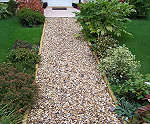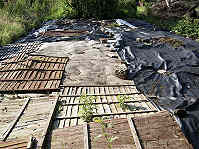Sheet Mulch
* Eliminate weeds around prize plants,
* Easy to do, fast, clean weed control,
* But are sheets really organic?
Sheet mulching is the best method to suppress existing perennial weeds. It has the advantage of being easy to lay down, pick up, relocate and store. Cutting to shape or planting through it are easy.
You can replace hoeing, and turning up more weeds in its wake, by using a fabric mulch. You will avoid hoe damage to roots of fruit and veg too.
Of course, sheet protection also keeps soil warm and moist, and protects delicate fruit like strawberries and marrows... from soil contact.
The tidy appearance of sheet mulch is improved further by a top covering of loose mulch such as bark or chippings. And of course, when you lay an aggregate of gravel an underlying sheet is essential to prevent mixing as the heavier stones sink and the lighter soil rises. >>
WHEN DO YOU REALLY NEED A SHEET MULCH?

MORE PAGES ABOUT GARDENING WITH MULCH

Polythene sheet held by fencing panels tames wild allotment fast
American organic gardeners - try this link to a tried & tested weed barrier
See below: weed suppression with sheets and above sheet cultivation, special sheets for tree rings and lawn borders, types of fabric and their use grow crops. As well as keeping bare ground clear you can use fabric to clear rough land of weeds.
How To Clear Weeds From A Rough Site
|
Sheets for weed suppression available to U.K. gardeners here
|
- First cut the weeds down to the surface,
- Dig a 12” deep trench around the area,
- Cover area with sheet and tuck it into trench bottom,
- Replace soil in trench to hold fabric down,
NEATEN UP AND UTILIZE PLOT WHILE SHEET SUBDUES WEEDS
- Cover the area with a suitable sheet, the edge tucked down to allow top drainage and smother weeds beneath as already described
- Raise the surrounding edge 3" - (you could use a row of bricks or logs), or for long boundaries especially, make a soil ridge
- Cover with bark mulch into which you can position potted flowers,
- Or cover the sheet with rough garden compost or old potting compost up to the ridge level about 3" deep and...
- Put in some bare root flower strips
- Or cut a few crosses into the sheet and plant straight through it. This risks the weeds coming through. Be alert
Perennial weeds will often find a way to the outside of the sheet and push up there. The trench makes this difficult. Any weed poking out around the outside of the sheeting should be cut off immediately.
PROTECT TREES SHRUBS AND LAWNS
Normally you would clear the site of weeds before planting trees or shrubs. Soil around trees and shrubs usually sees little change and is not regularly cultivated. So tree rings are becoming popular
Similarly the lawn border may be sheet mulched
^ Top of page
GROW CROPS
Sheet mulch is one way to reduce the need for hoeing weeds around crops. Strawberries are often grown on a low mounds topped by plastic sheeting. This also protects the delicate fruits from soil contact and may reduce slug and fungal attack. I’d expect the air above sheet mulched soil generally to be drier. While the plant roots beneath should benefit from more moisture.
Simply peg down plastic sheeting over the plot, make small holes for permeability if necessary and cut an X shape to plant through.
U.K. gardeners get tough porous weed control fabric here.
Any crop that is planted or transplanted can be inserted through a weed control fabric. This technique favours use with well-spaced larger crops, marrow, cabbage, outdoor tomatoes etc…
A considerable problem comes if you need to fertilize the soil. You can still apply folia feeds like fish emulsion, and seaweed extract, but it’s not as easy to feed roots. With larger crops, a slit may be cut for liquid feeding.
Slugs will no doubt take advantage underneath sheet mulch, for its cool moist environment and for protection from predators. But they may be put off if they don’t find herbs to graze on. Placing sharp stones or grit on the plastic will also deter slugs.
^ Top of page
Types of Sheet Mulch
GEOTEXTILEThese are permeable sheets either woven or non woven and needle punched, and made from polyester, polypropylene or similar polymers. They are not biodegradable.
They can be used to form barrier separation between soil and overlying loose mulch – gravel, wood chip... They effectively prevent perennial weeds in the soil beneath from greening up and, this leads to their demise.
BLACK (WHITE) PLASTIC SHEET
Silage sheeting (400 – 600 gauge) is recommended. It is impermeable. Black plastic sheet warms the soil and while keeping it moist. In greenhouses use white plastic sheet to reflect the heat onto the plants and keep the soil cool.
FIBRE SHEETS
These are made from bonded wood fibre. These are being developed for various garden applications from tree mats to flower seeded mats. They are of course bio-degradable.
^ Top of page
NEWSPAPERS
Paper is organic and it rots down in the garden. It is good material for suppressing weeds and keeping the soil moist. A whole newspaper at least 8 sheets thick should be used with heavier material: compost, weed-tops, and straw; to hold it in place.
Newspapers are well applied to vegetable plots because you can easily plant through it. They are also popular for use around fruit and under trees. Gardeners also report using it successfully over surface planted potato tubers where it retains moisture for good growth. Weed suppression is the big advantage of blocking out the light.
Spring is the best time to apply it. The paper softens to a paper mash. This can be forked in adding organic matter to the soil and encouraging worms. However, limit the use of highly coloured magazine papers as the inks contain heavy metals.
CARDBOARD
Brown cardboard is effective at suppressing weeds because it excludes light. Obtained from shops as used packaging material, it is the free organic mulch alternative to using plastic sheeting.
Even perennial weeds will be hard done by with a layer of cardboard to contend with. As it breaks down over time it encourages earthworms, and unlike plastic sheet it will let the air and water penetrate.
If you haven’t had time to dig out perennial weeds on a plot then apply cardboard in early summer. It's a good way to tackle a large area. You need to carefully weight it down at the edges with soil, or bricks or, you could place loose mulch on top.
An edging of bricks with garden compost or farmyard manure topping up to the bricks is good. This can be done quickly and easily and even planted up. Adding a topping obscures the unsightly appearance of cardboard.
^ Top of page
Now if all this time you've been wondering about pond liners and the like - I think they are better described as Geomembranes. Of course geomembranes are impermeable.
BOTTOM OF THE GARDEN HEAP - more information and links
Find more links about Flower Gardening below:
|
Flowers For
Home |
More Help On
Flower Garden Design |
Grow Your
Own Flowers |
|
|
> > |
> > > |
> > > |
> > > |
ALSO on the-organic-gardener.com
-
My Neighbour's Flower Garden Design
The Flower Expert is here.How to make a beautiful & productive garden with Sarah Raven - click link.
The Royal Horticultural Society is on this link plus... ...
Pictures of the growing landscape for the London Olympics
Do you run a gardening website - with information to interest my visitors? To set up exchange links from/to suitable pages - click here.

Custom Search
- The Home Of The Organic Gardener - growing naturally, pure and beautiful.
^Get on top of your garden with sheets

Copyright © The Organic Gardener.Com 2004 - 2020.

[?] Subscribe To This Site
- Organic Garden Blog
- Grow More Flowers
- Grow From Seeds
- Grow Better Lawns
- Grow Potatoes
- Organic Fertilizer
- Weed Control
- Garden Tool Shed
- Garden Power Tools
- Garden Shredders
- Grow With Compost
- Gardening Gifts
- Gardening Books
- Crop Rotation
- Organic Pest Control
- Runner Beans
- Mulch It
- Garden Watering
- Moving Shrubs
- About Organic
- About the Gardener
- Organic Links
- Contact the Gardener
- Privacy Policy



